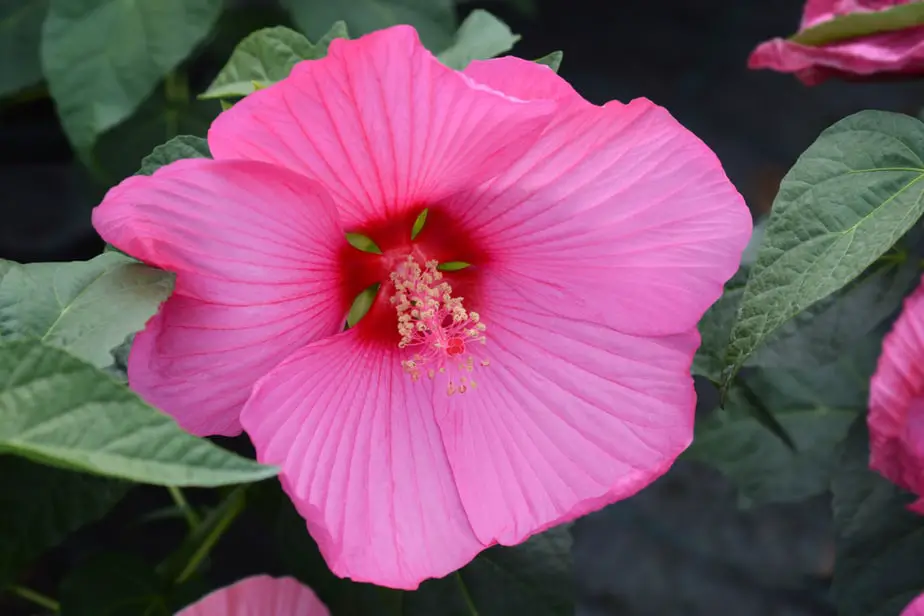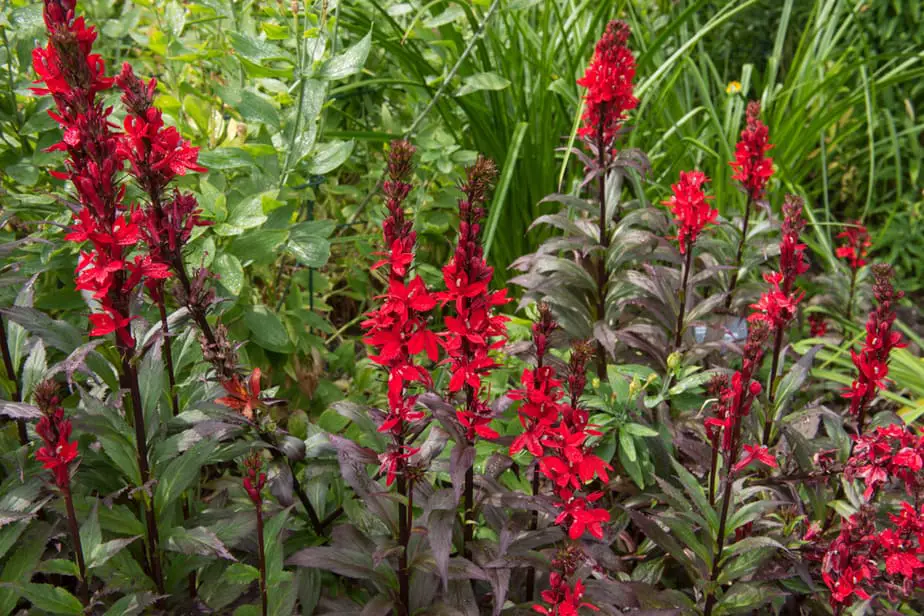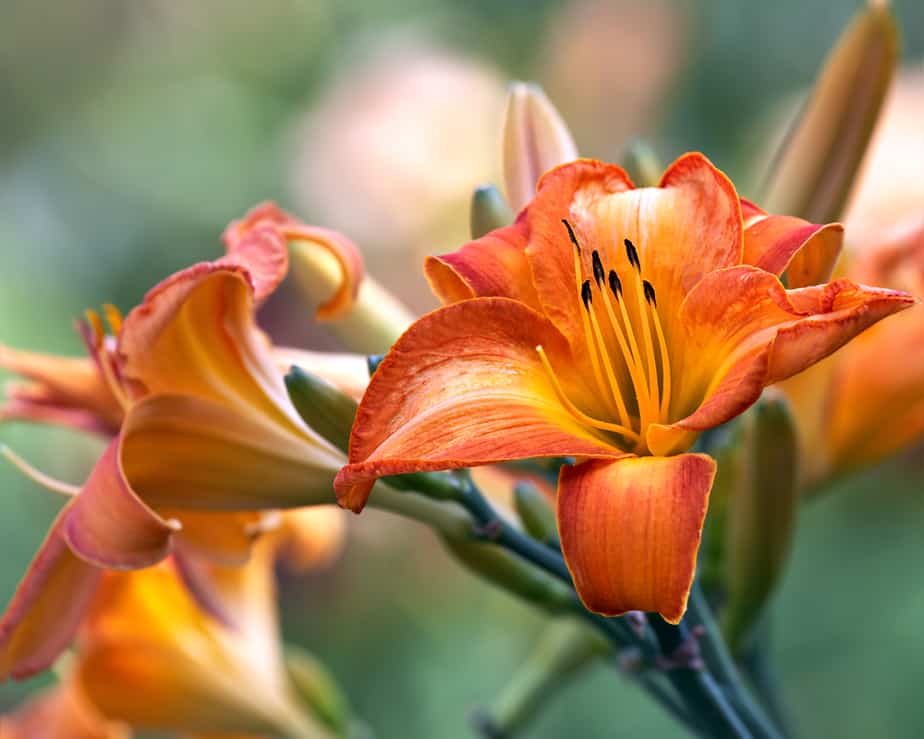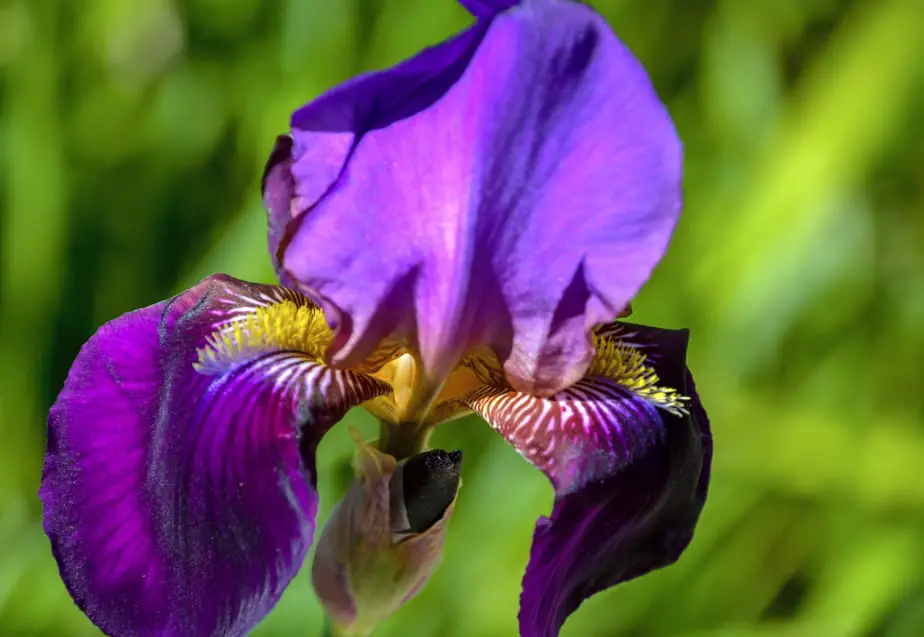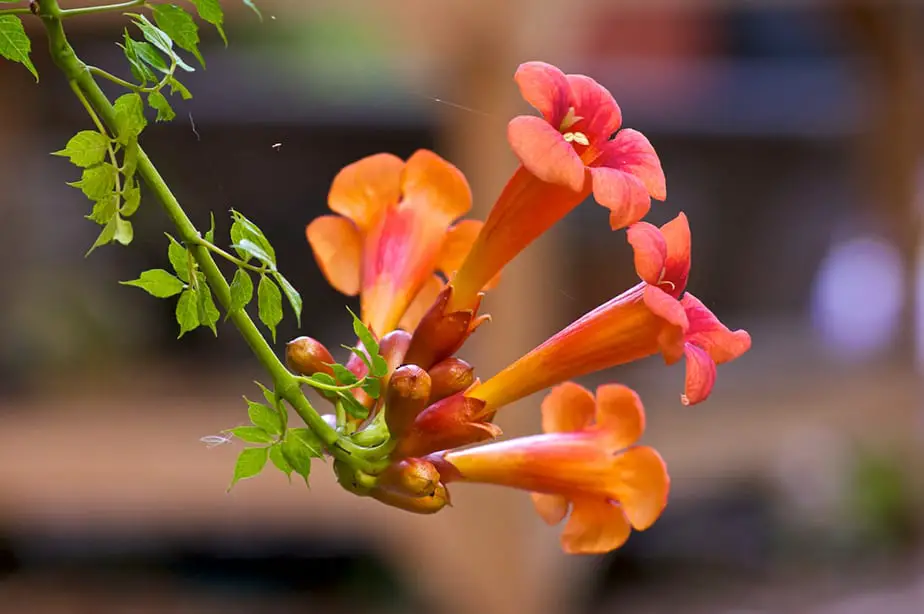Whether you live in a wet climate, are looking for plants to put near your ponds, or just have land that likes to flood after rains, it can be frustrating trying to find vegetation that can withstand the build-up of water. Frustrating – but not impossible!
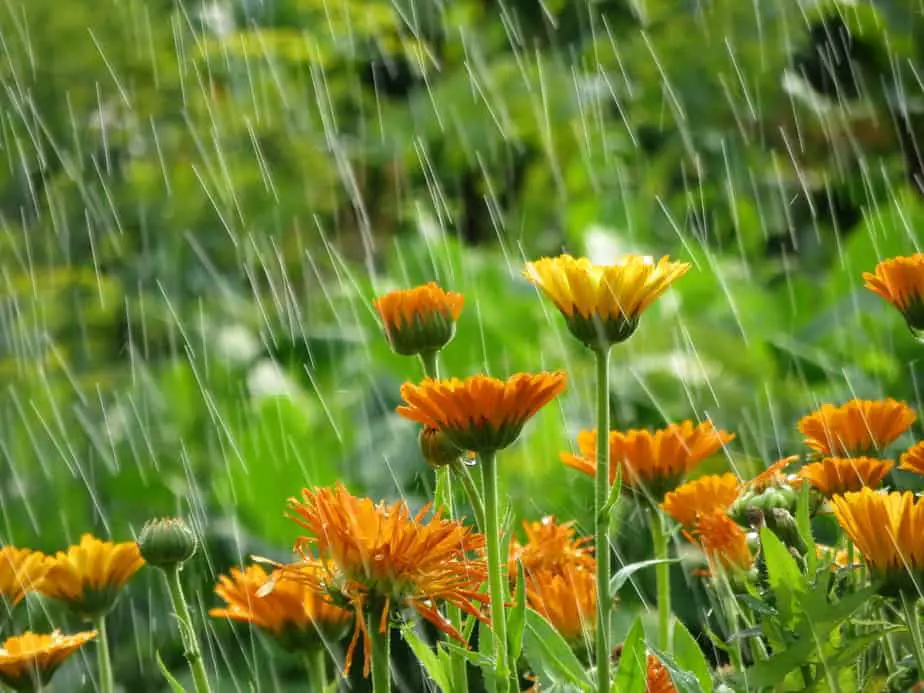
Wet soil loving plants can be natural solutions to drainage, runoff, and erosion problems. Plus, they’re simply gorgeous to look at and will bring color and texture to areas of your property that may have otherwise laid bare.
In this article, we’ll be going over 21 various plants. Some of the plants on our list tolerate moist soil, others do best when their roots are completely submerged, and some can thrive in both conditions!
Let’s get started!
Table of Contents
Plants that Tolerate Moist Soil
1. Hardy Hibiscus
They’re called hardy for a reason.
Hardy Hibiscus plants are extremely easy to grow and love moist soils (but can adapt to practically any type of soil). They do require full sun, but with the simple combination of dirt and light, these plants can produce colorful blooms up to 12 inches in diameter! Hardy Hibiscus will usually flower in the late spring and they’re at their best during hot summers.
Though they thrive best during the warmer months, these durable plants can even make it through winters as far up north as Hardiness Zone 4 (surprise, surprise).
2. Cardinal Flower
The Cardinal Flower is a beautiful bright red plant, beloved by gardeners and hummingbirds everywhere. It thrives best in constantly wet or moist soil with partial sunlight, but Cardinal flowers can also do well in full sun.
Cardinal Flowers get their name from the striking resemblance of their flowers to a Roman Catholic Cardinal’s red robe. They grow anywhere between 1 and 6 feet tall and are most commonly found in swamps, near large bodies of water, and stream banks.
3. Daylily
Daylillies are lovely flowers of brilliant oranges, yellows and cream colors. They’re quite the strong plant, able to thrive in wet or dry soils. They prefer full sun but do fair well in partially shaded areas. However, if you’re wanting the most blooms possible, we recommend planting Daylillies in constant, direct sunlight.
These flowers are one of the many on our list with a deep root system, helping to slow or stop any erosion that you may have on steep hillsides or water banks. They’re also easy to care for, simply requiring a trip of dead blooms here and there.
4. Iris
Irises are deeply rugged flowers, great for planting nearly all year round (from spring and midsummer to fall). And not only are they reliable plants, but they’re also easy to grow and don’t require much babying, even as bulbs.
Like the Daylillies that we covered previously, Irises will bloom to their fullest when planted in areas that receive full sun. Though they also do well in areas with partial shade. They like moist soil but won’t do well in standing water, so be sure to choose a planting location that isn’t prone to puddling or flooding.
5. Trumpet Creeper
Trumpet Creeper Vines do extremely well in damp soils – so well, in fact, that they’ll invade and suffocate any other plants in their path as they grow. Aside from being invasive, they make gorgeous additions to bare land near ponds or on a hillside and, because of their deep roots and strong vines, can help with erosion and runoff tremendously.
Creeper Vines bloom the most when given full sun. These plants would be better suited for areas that you can easily keep under control, such as next to a walkway or up against the house, or in places that are barren and low-lying so that they can freely spread without being too much of a nuisance.
6. Bee Balm
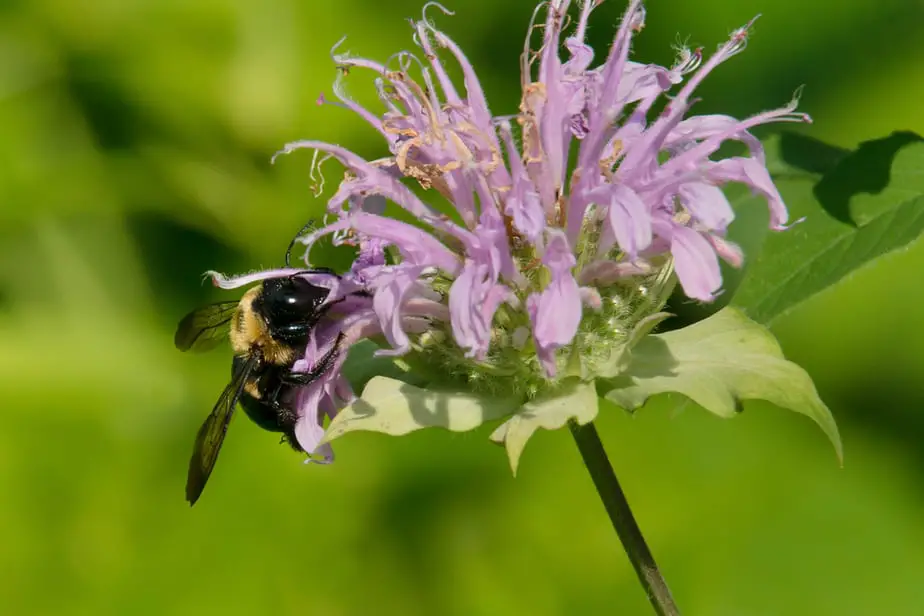
As its name entails, Bee Balm is a master at attracting bees. So not only will it bring beautiful lavender blooms to your yard, but it’ll also invite top pollinators.
Bee Balm is a hardy flower that does well in both drought and damp conditions. Although, it does thrive far better in moist soil and (like most plants) likes to be watered frequently during hot weather spells. Though Bee Balm prefers moist soil, it doesn’t fair well in standing water, so be discriminatory when searching for a planting location.
This plant will survive throughout the winter and does spread come spring and summertime, though not as quickly or ruthlessly as other plants in the Mint family.
7. Royal Fern
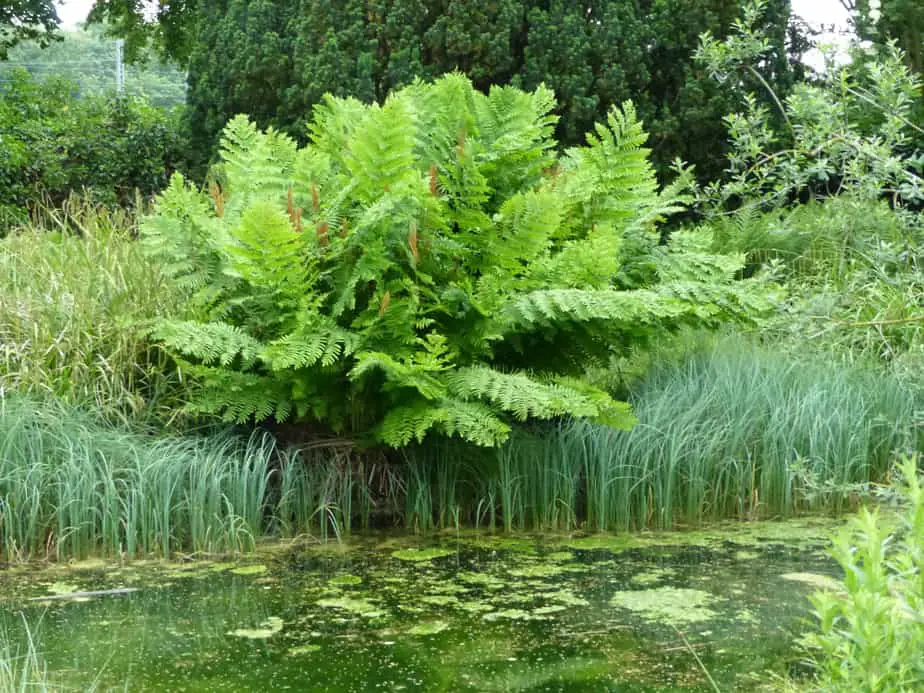
As you can probably tell by the photo above, Royal Ferns thrive astonishingly well in damp soil – especially near bodies of water. Though deep submersion isn’t ideal, Royal Ferns can tolerate year-long shallow standing water.
Royal Ferns would be wonderful for taking up space in barren areas around lakes, ponds, water gardens, or streams, considering the fact that they have the potential of growing to huge sizes.
8. Spiderwort
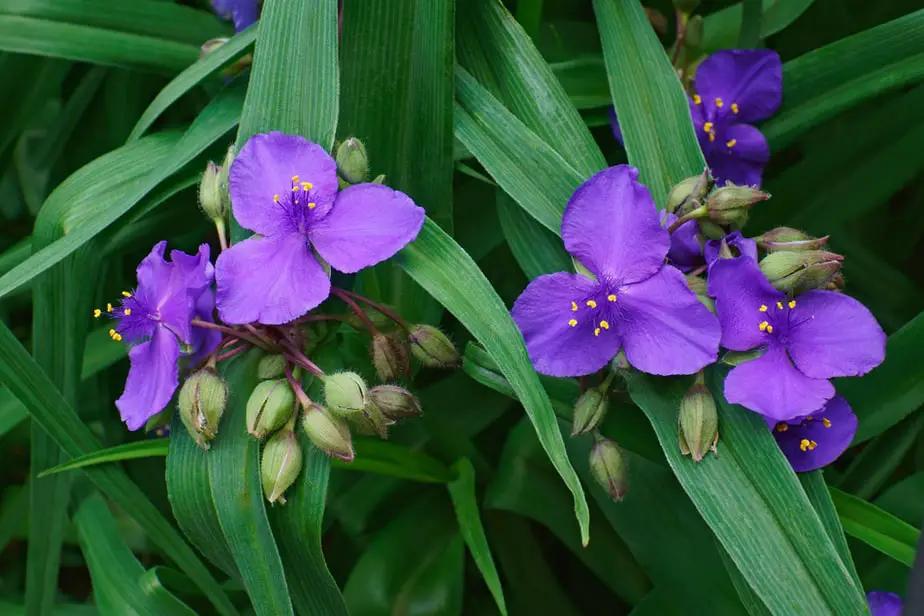
Spiderwort is a very adaptable flowering plant. It can tolerate dry and damp soils but grows best when in moist earth. Not only can it tolerate various soil conditions, but also various light conditions. Spiderwort can be planted in full sun, partial sun, or in shady areas with little to no problem at all.
This plant adorns itself with blossoms of blues, whites, and violets with the most common being shades of purple. Spiderwort can be invasive when under the proper conditions. So, you may want to keep them contained in a garden bed. But, if you prefer, you can simply let them run wild next to a creek or down slopes to help with poor drainage or erosion.
9. Canna
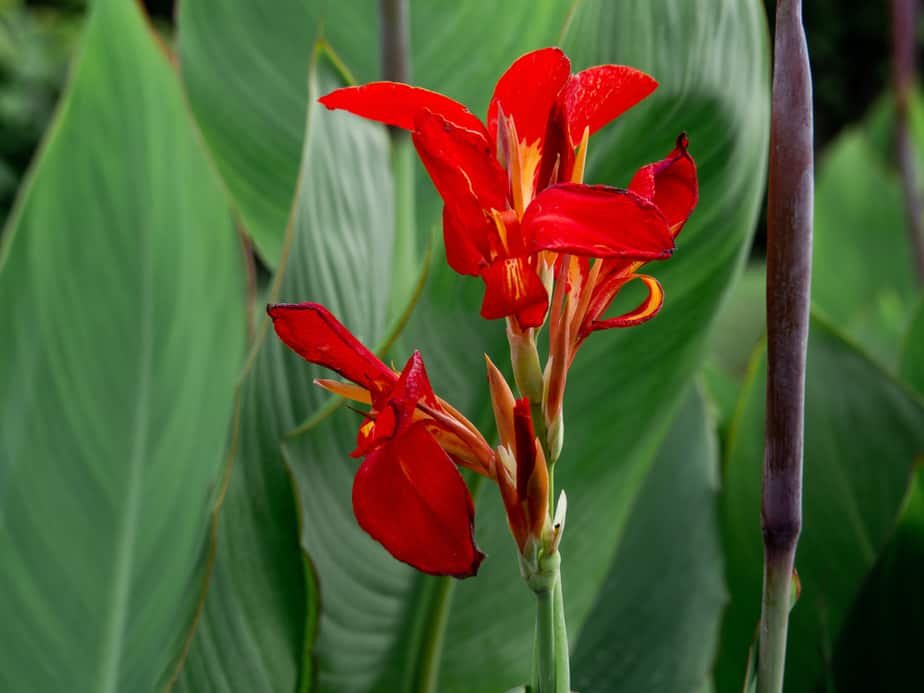
Bright and beautiful, Canna is a wet soil loving plant that would add a colorful flair to any garden. They prefer full sun but can do well in partial shade. While they like damp soils, they can’t thrive well under wet conditions, so be careful as to not put them in any low-lying areas or flood zones.
These are tropical plants that love the heat so when planted in the United States, the further south you are, the better. Cannas prefer temperatures of 75 degrees and up. They will not make it through harsh winters or do well in weather that is below 70 degrees.
10. Turtlehead
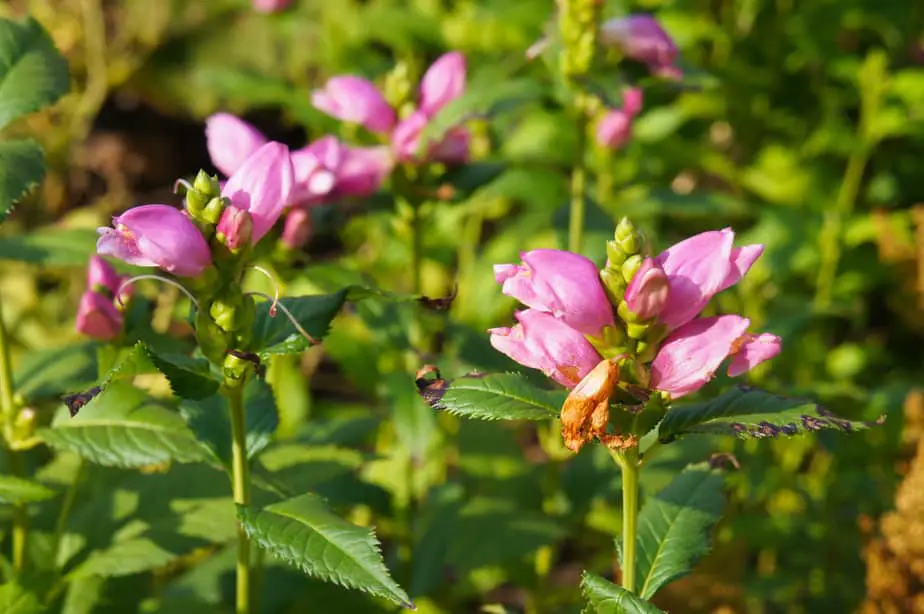
Earning the name from their turtlehead-shaped blooms, Turtleheads are pretty plants that grow between 2 and 3 feet tall and in clusters around 3 feet wide. They’re mainly found in the easternmost part of the United States and fair well in damp or wet soils along riverbeds, stream banks, and large bodies of water.
They prefer full sun but do okay in partially shaded areas. Turtlehead is better suited for Hardiness Zones 4 through 8 and is best planted in early spring once the weather begins to warm.
11. Forget-Me-Not
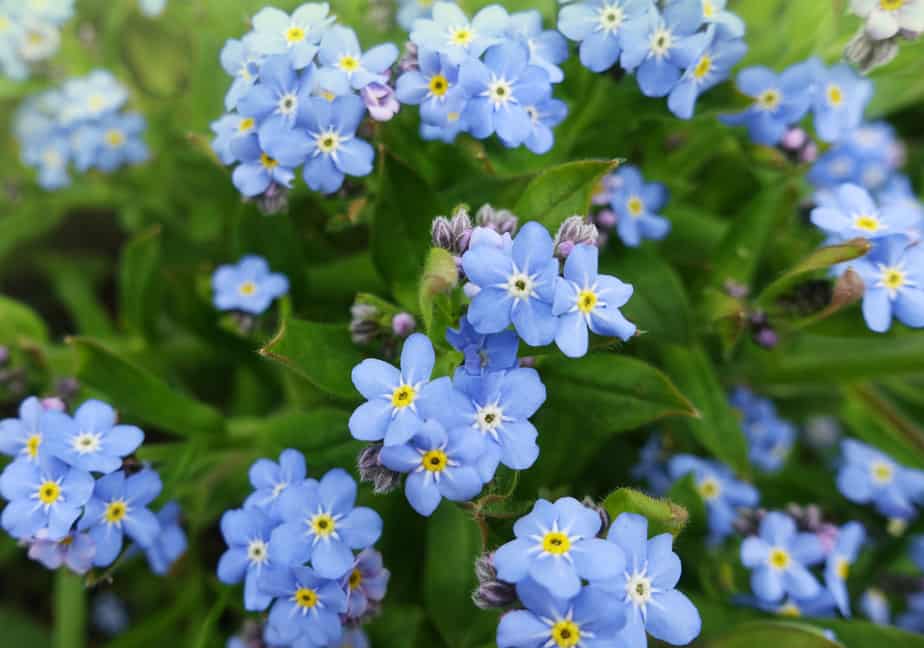
Native to the United States, Forget-Me-Nots are a low-maintenance solution to bald patches of land. They efficiently reproduce, gently spreading along the yard over time (without being wildly invasive).
Their beautiful baby blue blooms take over their long, lanky stems during May and through October. Forget-Me-Nots love damp, moist soil but don’t like to be in standing water so be sure not to plant them in areas that may collect water.
These would be great options for planting in either full sun or partial shade near bodies of water.
12. Marsh Marigold
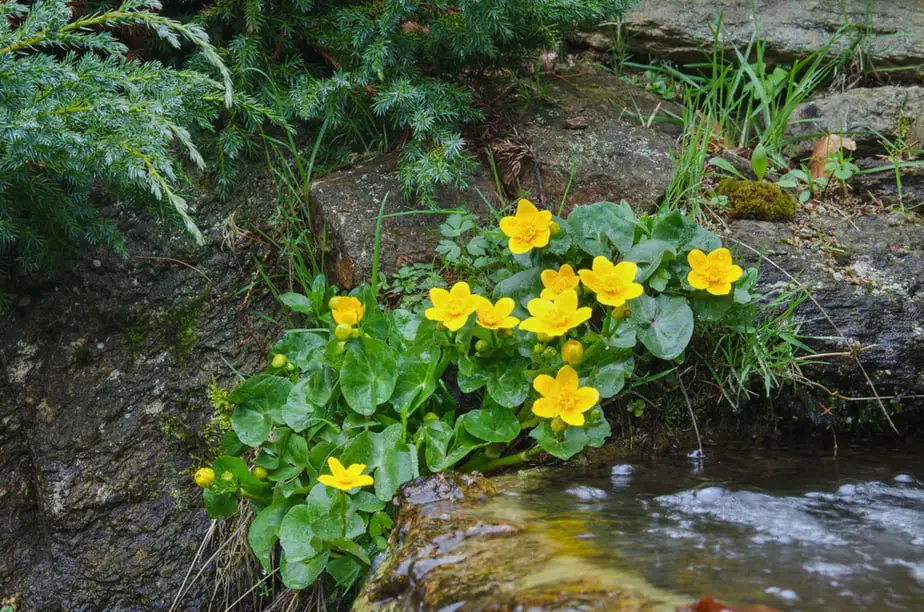
Wet soil loving plants like the Marsh Marigold are dependant on a constant source of moisture. Though they don’t like to be submerged, Marsh Marigolds thrive next to running creeks and near other bodies of water.
They’re most commonly found in places of partial or complete shade, such as woodlands and marshy hollows. They can grow anywhere between 1 and 3 feet tall and dress their thick stems with many clustered yellow blooms and heartshaped leaves.
13. Hydrangea
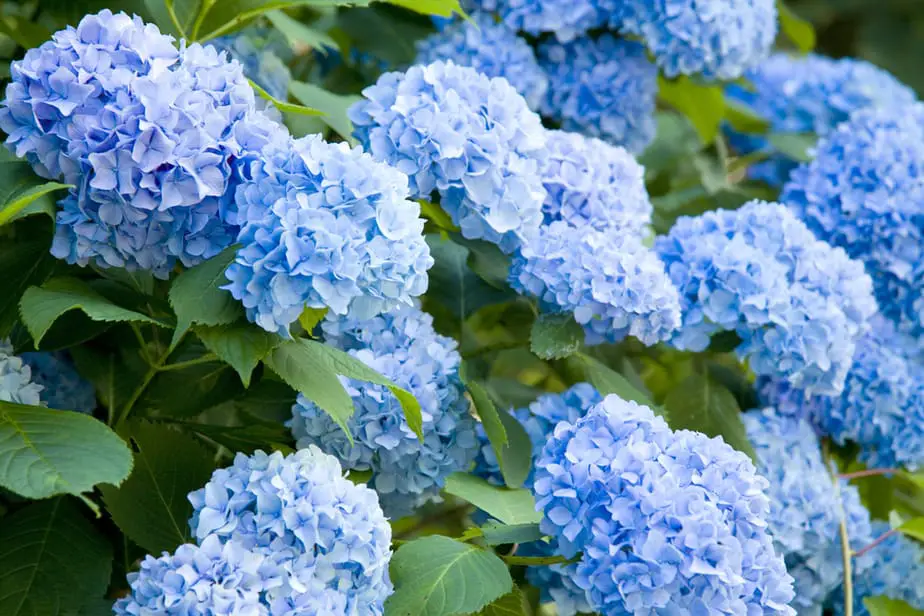
Some of the most common wet soil loving plants, Hydrangeas are beloved vegetation. Hydrangeas are shrubs that produce brilliant, large blooms of varying colors. The colors range from light to deeper blues, pinks (sometimes varying to reds), whites, purples, and occasionally light greens.
Depending on the type of Hydrangea you plant, their size can be as little as 3 feet tall and wide or as large as 15 feet tall and wide. In the U.S., these plants do best in Hardiness Zones 3 through 9.
When planted further north, Hydrangeas can tolerate full sun. But further south, Hydrangeas won’t be able to take the heat as well and will need to be planted in partial-shade – preferably in an area that receives sunlight in the mornings rather than midday.
14. Virginia Sweetspire
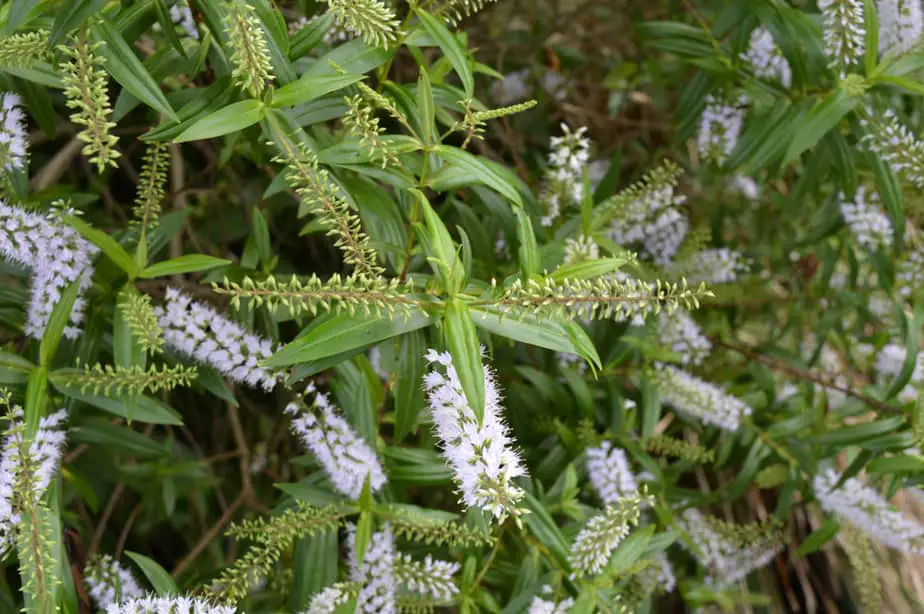
Virginia Sweetspires are shrubs with lanky limbs and long, 4-inch blossoms of white flowers. They grow anywhere from 3 to 8 feet tall and look beautiful in large clusters of individual shrubs.
This is a semi-evergreen plant whose leaves turn red and purple during the fall. Virginia Sweespire does incredibly well in wet and moist soils and therefore can thrive well into the winter months. These plants prefer to be placed in areas of full sun (when planted further up north) or partial shade (when planted further south).
15. Winterberry Holly
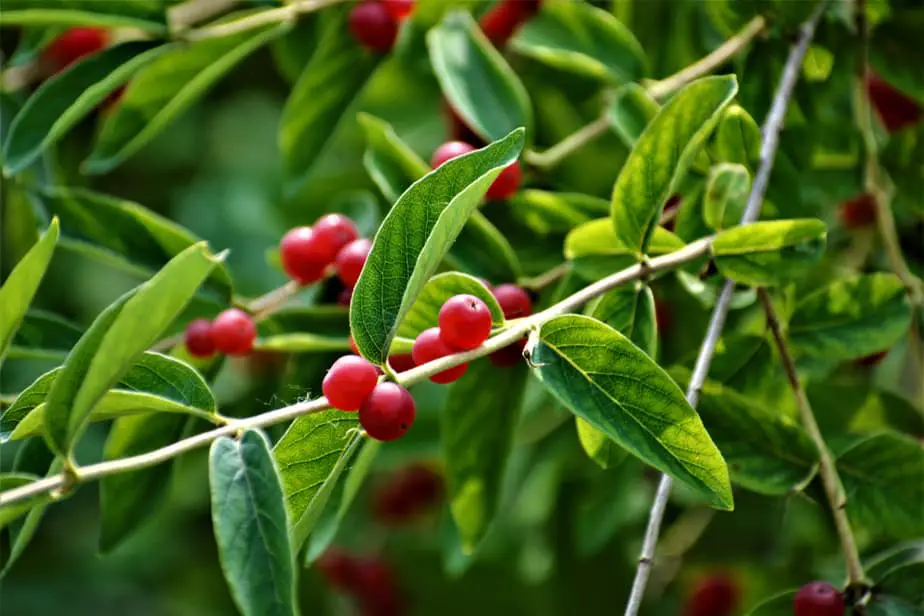
It’ll be a holly jolly Christmas in your yard with this wet soil loving plant.
Winterberry Holly is best known for its bright green leaves and fiery red berry bundles. Unlike other Holly plants, Winterberry is not evergreen, meaning, whenever winter rolls around the leaves will blacken and fall, leaving only the clusters of bright berries.
They’re adaptable to both wet and dry soils, but they do enjoy moist dirt primarily and require a ton of watering if placed in dry landscapes. This plant does well in full sun, part shade, or full shade.
Winterberry is also wonderful for attracting birds to your yard during snowy months.
16. Dogwood
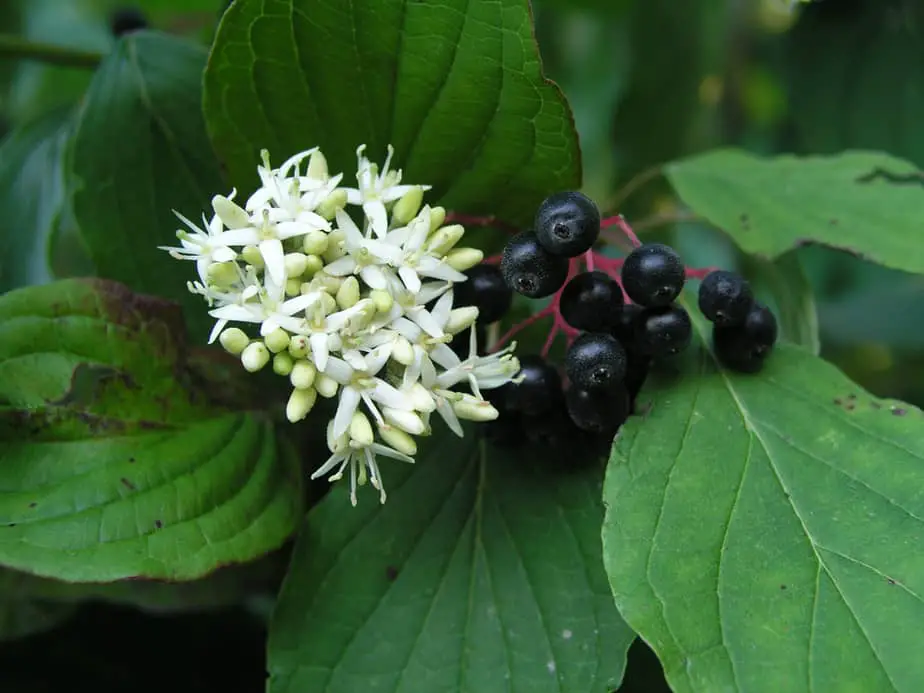
Dogwood Trees are a larger, more permanent wet soil loving plant option on our list. Large and permanent, but gorgeous and eye-catching all year round!
While Dogwood is only covered in brilliant white blooms for around 4 weeks during early Spring, they’re adorned with bright green leaves during the warmer months and red leaves during the Fall. During the winter, after their white blossoms and vibrant leaves have passed, Dogwood Trees can often sprout red berries to make up for the lack of color.
These trees prefer areas of full sun or part shade and like damp, but well-drained soils.
17. Joe Pye Weed
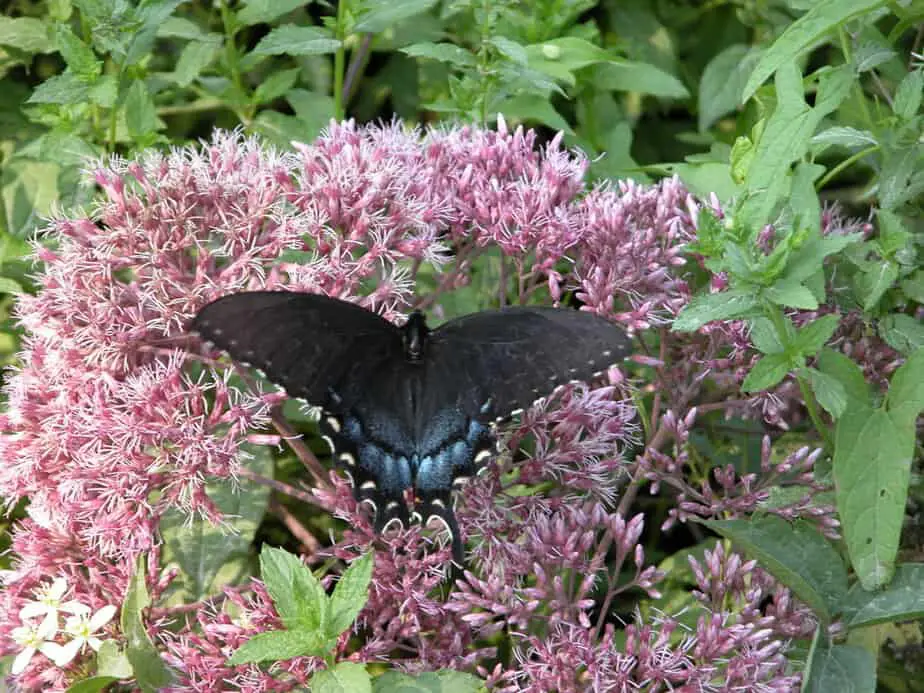
The Joe Pye Weed is a wet soil loving plant that can grow up to an incredible 12 feet when given year-long moist conditions. But on average, these large green plants vary in size, anywhere from 6 to 12 feet. They sprout beautiful violet blooms in giant dome shapes that can span up to a foot across.
Joe Pye Weed is naturally found in marshes, along stream banks, and in watery meadows. These would be wonderful plants to have near lakes or ponds and would make great fillers for barren areas.
These are quite the large source of nectar, making Joe Pye Weed a much-desired plant by butterflies, birds, and other pollinators alike; so you can expect your land to be taken over by dancing wildlife during the warmer months (when the plant is in full bloom).
Plants with Roots that Prefer to be Submerged
If your property has low-lying areas that often flood or hold stagnant water, these plants would be wonderful options to add color and intrigue to an otherwise barren piece of property.
18. Cattail
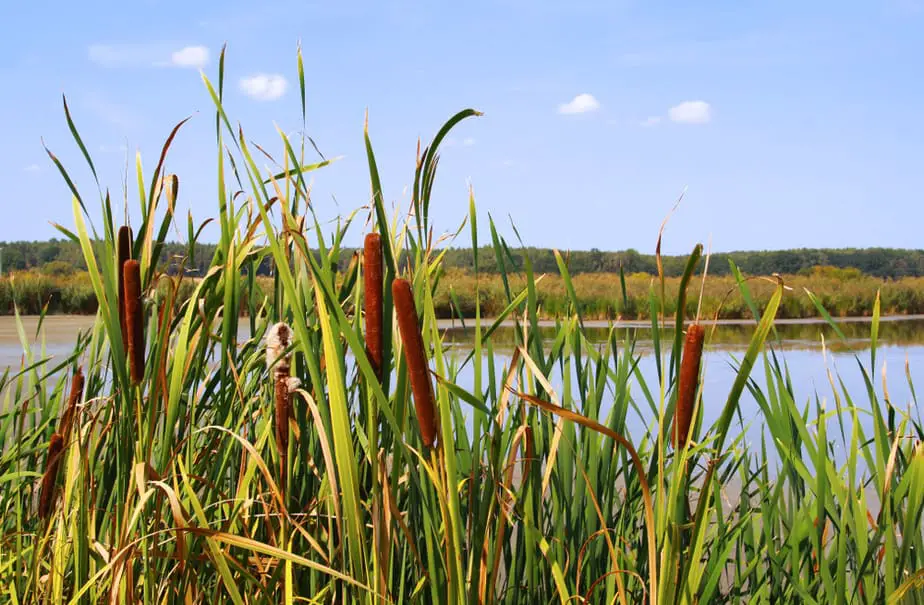
You can spot Cattails a mile away – and not only due to their sheer size but also because of their striking resemblance to a cat’s tail. Cattails, one of the most well known wet soil loving plants on our list, are mostly found near large bodies of water such as rivers, lakes, marshes, and ponds.
When given the proper conditions (access to huge pools of water with shallow shore flooding and warmer weather), Cattails can grow up to 10 magnificent feet tall and spread like wildfire. These plants love when their roots are submerged, often planting their roots in nearly 2 feet of water.
19. Pickerel
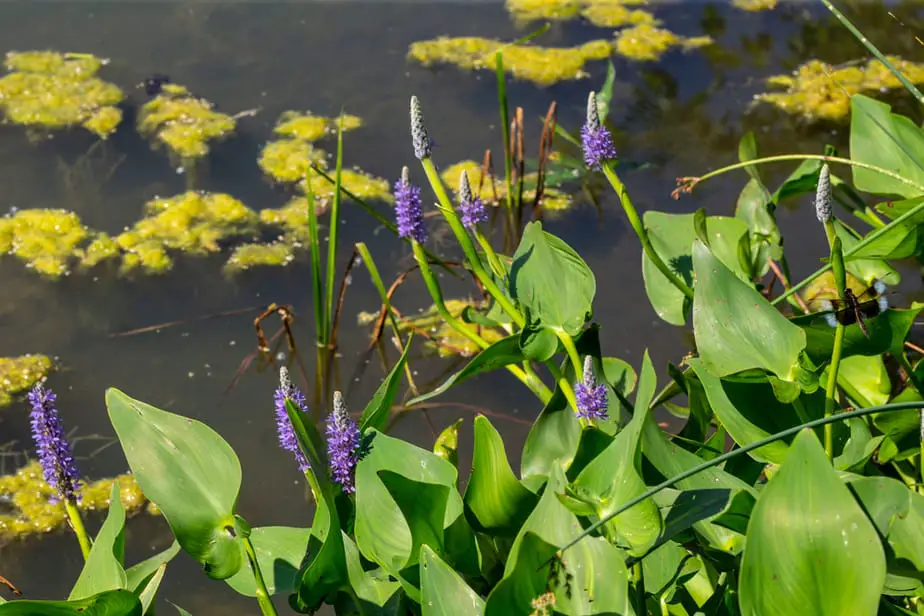
Pickerel, also known as Pickerelweed, is a true water-loving flowering plant. It prefers its roots to be submerged, making it an ideal plant for water gardens and around ponds, right off the edge of the bank.
These plants require full sun but can tolerate partial shade. In ideal conditions, Pickerel can spread rapidly and grow up to 3 feet tall. If you don’t want them growing too large or taking over the edge of your water features, be sure to trim back and divide the plants.
20. Elephant’s Ear
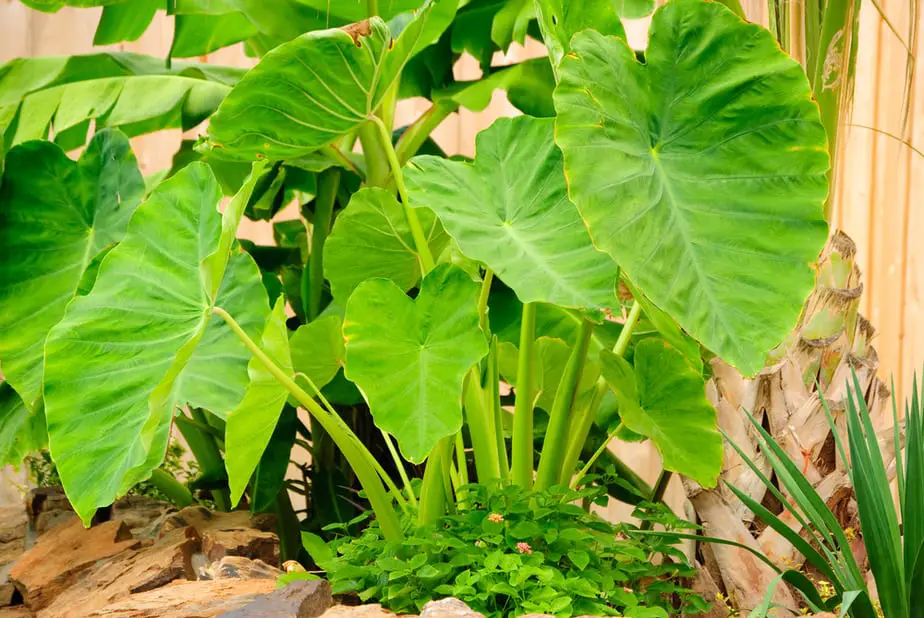
As you can probably conclude from the name, Elephant’s Ear looks… well… like the ears of an elephant. They’re large plants that give a dramatic, tropical vibe to any garden they’re placed in.
Like the other wet soil loving plants in this section of our list, Elephant’s Ear prefers to have their roots submerged but can tolerate living in extremely damp soil. They do well when placed in full sun or in areas of partial shade and can grow anywhere from 3 to 10 feet tall and 2 to 10 feet wide. Elephant’s Ears are best suited for and thrive in U.S. zones 7 through 12 but are considered invasive along the Gulf Coast, so be wary of that.
These would look especially striking in a rainforest-themed water garden alongside other various exotic plants.
21. Creeping Jenny
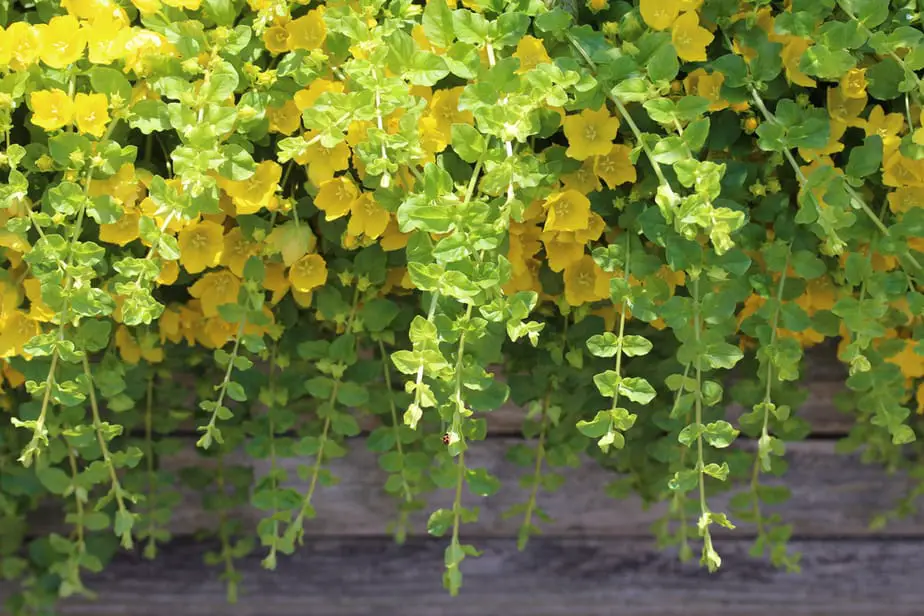
The last plant in our wet soil loving plants list, Creeping Jenny is a bright and beautiful ornamental. When in full bloom, Creepy Jenny is covered in glorious golden flowers and bright green leaves.
Creeping Jenny is a low-lying plant that would do well in wet rock gardens or in the steady stream of a water garden waterfall. They grow best in zones 2 through 10 and thrive in areas of both full sun or shade. This plant can take over your garden fairly quickly, so if you’re looking to keep in restrained, be sure to prune your Creeping Jenny often.
Final Thoughts
When it comes to low-lying areas, flood zones, and rainy climates, finding colorful, decorative plants can be a hassle. Luckily, wet soil loving plants are the perfect cure to all of your gardening frustrations. They’re hardy, great fillers for bald landscapes, and are just plain beautiful.
As we wrap up our article, we hope you were able to find your ideal floral match and leave us feeling more confident that you can now begin to seriously own your yard.
